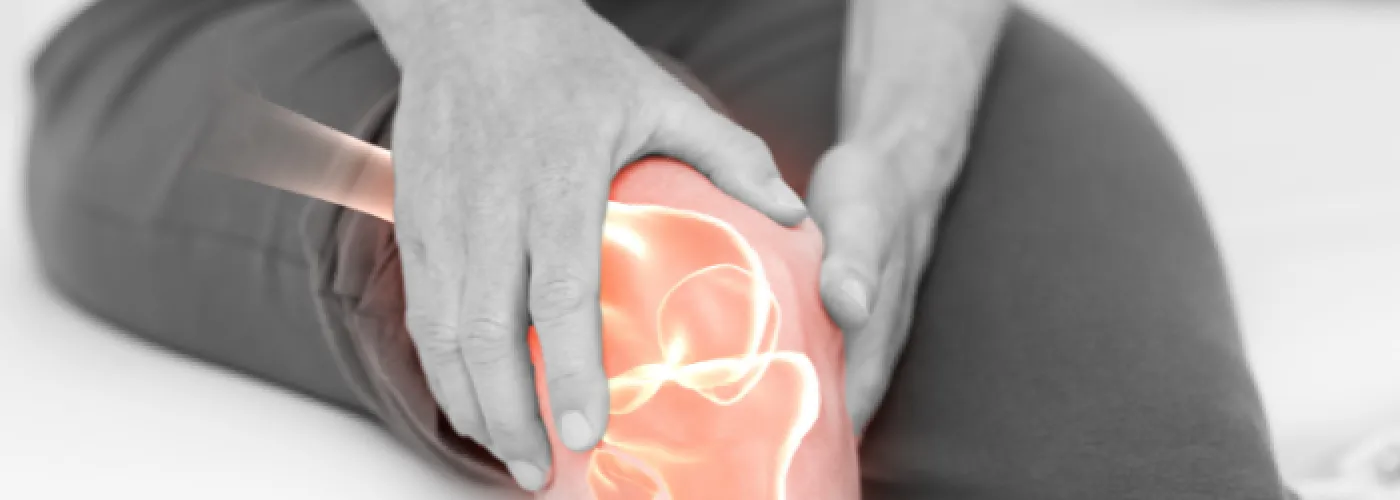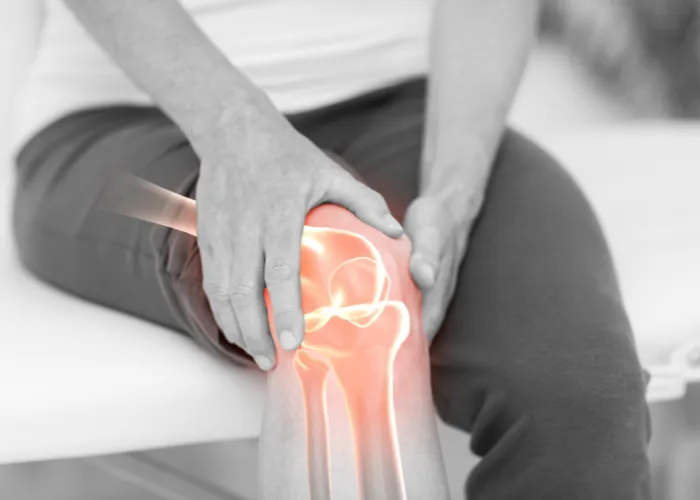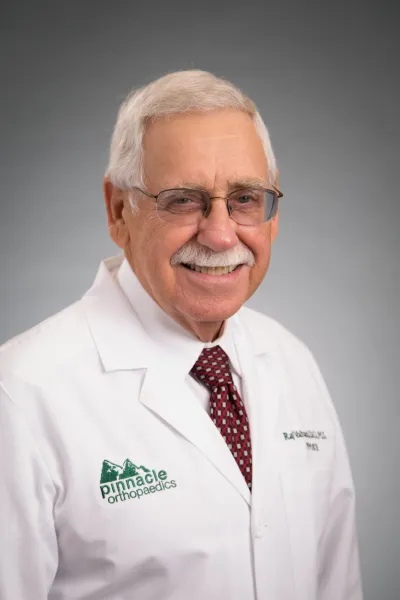
Knee

The knee is the large lower extremity joint connecting the femur and the tibia. The knee supports nearly the entire weight of the body and is vulnerable to both acute injury and the development of osteoarthritis.
Anatomy and structure of the knee
The knee is a complex synovial joint that hovers and actually is comprised of two separate joints. The femoral-patellar joint consists of the patella, or "kneecap," which sits within the tendon of the anterior thigh muscle and the patellar groove on the front of the femur through which it slides.
On the other hand, the femoral-tibial joint links the femur, or thigh bone, with the tibia, the main bone of the lower leg. The joint consists of a viscous fluid which is contained inside the "synovial" membrane, or joint capsule. Behind the knee is called the popliteal fossa.
Furthermore, the knee bones are connected to the leg muscles by several tendons that move the joint. Ligaments join the bones and provide stability to the knee. Some of the specific structures of the knee are as follows:
Femur: Thigh Bone
Tibia: Shin Bone (Main lower leg bone)
Fibula: Calf bone
Patella: Knee Cap
Anterior Cruciate Ligament: Prevents the femur from sliding back on the tibia and vice versa - the tibia sliding forward on the femur.
Posterior Cruciate Ligament: Prevents the femur from sliding forward on the tibia and the tibia from sliding backward on the femur.
Medial and Lateral Collateral Ligaments: Prevent the femur from moving from side to side.
Medial and Lateral Menisci: Two C-shaped pieces of cartilage that act as shock absorbers between the femur and tibia.
Bursae: Fluid-filled sacs that make the knee move smoothly.
When to see an orthopedic doctor?
Pain in the knees does not usually point to a serious condition. More often than not, your knee pain may be a product of a mild muscle strain or bruising that usually goes away on its own.
But if the pain worsens or becomes persistent over time, then it warrants a visit to your trusted orthopedic specialist. Some of the signs and symptoms that may accompany your knee pain include:
Swelling or inflammation
Soreness, stiffness, and redness
Muscle weakness
Instability
Mobility difficulties
Popping sound in the knees
These symptoms usually mean that you have a knee condition caused by aging, overuse, or injury. So if you're currently experiencing such things, then it's time to seek medical attention right away.
You are also at a high risk of sustaining a knee condition if you are overweight, an athlete, or have a previous injury or knee surgery.
Common knee injuries and conditions
Some of the most common knee conditions and injuries that people of all ages may sustain include the following:
Knee strain and sprain
A knee sprain occurs when a ligament gets stretched out beyond its normal limitations or sustains some damages. On the other hand, a strain happens when a muscle or tendon in the knee gets stretched out too far.
A knee sprain and strain typically happen while playing sports when the muscles get overused or damaged after a sudden movement. Fortunately, these types of injuries can be treated with rest, icing, compression, and medications.
Ligament tear
The knees are made up of four bands of the ligament that hold the knee joint together and facilitate movement. However, these ligaments can get injured after a direct blow to the knee (e.g., a car accident), sudden changes in direction, or a bad landing.
The anterior cruciate ligament or ACL is the most common ligament to be injured, especially in sports. When it gets torn, the patient will immediately experience severe pain, instability, and a feeling of "giving out" in the knees.
Meniscal tear
A meniscus refers to a piece of rubbery cartilage that can be found between the shinbone and the thighbone. It acts as a shock absorber and protects the two bones by preventing wear and tear.
Meniscal tears can happen after being tackled, an aggressive knee twist, or rapid direction changes while bearing weight on the knee. This can occur while playing contact sports, such as football.
Furthermore, the cartilage in the knee may suffer from wear and tear due to aging, making it more vulnerable to tears even with mild movement.
Tendon tear
The knee consists of two types of tendons: the patellar tendon and the quadriceps tendon. These two are responsible for the knees' ability to bend and straighten during movement. Partial or complete tears can cause severe pain, swelling, a tearing sensation, and mobility problems.
Most tendon tears rupture as a result of a falling injury, a jumping accident, or an underlying knee condition, such as tendonitis.
Fracture
A knee fracture refers to an injury characterized by a break in the patella or the bone that houses the knee joint. It is a serious injury that's usually caused by a violent blow to the knee, such as in vehicle collisions and sports-related accidents. There are four types of patellar fracture:
Stable or nondisplaced—a tiny break in the bone; a fracture of only by a millimeter or two. A nondisplaced fracture may be treated with non-surgical methods since the bones are still aligned and in contact with each other.
Displaced fracture—a completely separated and malaligned bone that require surgery to fix.
Comminuted—a fracture characterized by three or more breaks in the bone.
Open fracture—this is a severe type of fracture wherein a bone fragment punctures out of the skin.
Arthritis
Arthritis is a chronic illness that can affect any joint in the body, such as the knees. It has over a hundred types but the most common ones to plague the knees are:
Osteoarthritis—is a degenerative form of arthritis characterized by the gradual fraying of the cartilage between the knee joints. This disease often occurs as an individual age, causing the cartilage to become stiffer and thinner.
Rheumatoid arthritis—is an autoimmune disorder wherein the immune system creates antibodies to attack several joints in the body. Specifically, these antibodies target the synovium, thus disrupting the supply of lubricating fluid in the knee joint.
Posttraumatic arthritis—this type of arthritis occurs as a result of a previous knee injury or condition, such as a meniscus or ligament tear.
Patellar tendonitis
Patellar tendonitis, or jumper's knee, is an inflammation in one or more of the tendons that connect the patella to the shinbone. It is a common injury for athletes, which occurs when the knee sustains repetitive stress, thus irritating and inflaming the tendons.
Other causes of tendonitis in the knee include obesity, another knee joint condition, and uneven leg muscle strength.
Knee bursitis
A bursa is a fluid-filled sac found in several joints of the body, usually located between muscles and tendons. Its main function is to reduce friction by providing a cushion between bones and muscles as they glide over one another during movement.
However, it can get irritated or injured as a result of repetitive motion, joint overuse, or trauma. This then results to inflammation, which is a condition known as bursitis.
Treatment options for knee injuries
Mild knee conditions and injuries may be treated using non-surgical options, such as medications, immobilization, physical therapy, or steroid injections. But if these methods fail to manage your symptoms, then your doctor may recommend surgical treatment techniques, such as:
Knee arthroscopy
This is a minimally invasive technique used to diagnose and treat problems affecting the knee joint. It involves using small, specialized instruments, like an arthroscope, to access the joint through tiny incisions in the skin.
During arthroscopy, your surgeon can perform plenty of techniques, such as skin grafting, repairing torn muscles, or removing loose fragments inside the knee joint.
Partial knee replacement
This involves the removal of the damaged bone and cartilage on one part of the knee and replacing it with artificial implants. The part that's unaffected by the condition will be preserved. Doctors typically use partial knee replacements in cases of osteoarthritis and rheumatoid arthritis.
Total knee replacement
If the inside (medial), outside (lateral), and kneecap are all damaged, then a total knee replacement is needed. It is a procedure that replaces all the damaged parts with prosthetic implants made of metal or plastic.
Pinnacle Orthopaedics—home of high-quality knee surgery technology
At Pinnacle Orthopaedics, your health and quality of life are our priority. Our board-certified physicians are passionate about providing superior medical care and treatment services for a full spectrum of knee conditions. We offer a range of non-surgical and innovative surgical techniques一from physical therapy to robotic assisted total knee replacement and maci procedure of the knee.
Contact us now or visit one of our convenient locations near you:
The material contained on this site is for informational purposes only and DOES NOT CONSTITUTE THE PROVIDING OF MEDICAL ADVICE, and is not intended to be a substitute for independent professional medical judgment, advice, diagnosis, or treatment. Always seek the advice of your physician or other qualified healthcare providers with any questions or concerns you may have regarding your health.









